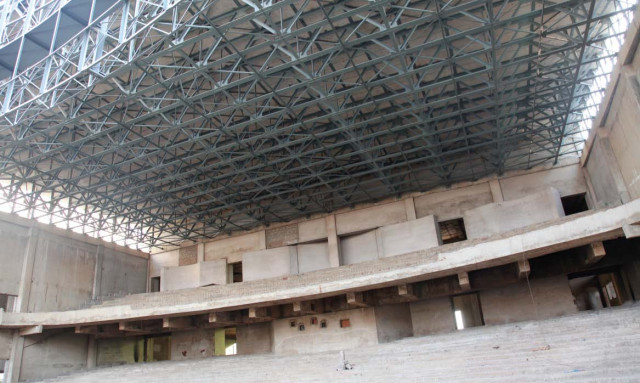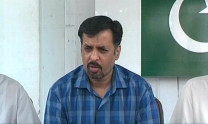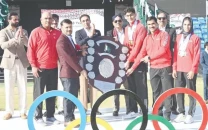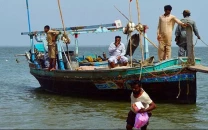To be or not to be: Construction of country’s largest auditorium left midway
Mustafa Kamal launched the Fyzee Rahamin gallery and auditorium project in 2008.

Pakistan’s largest indoor theatre has been in a macabre half-skeletal state for almost two years. The abandoned project will remain incomplete as long as the city administration continues to scrape together the funds. It could be a long wait, however, as long as other projects are given priority over entertainment.
The bare, brick-walled structure of the Fyzee Rahamin Art Gallery and Auditorium stands between the Supreme Court and the Arts Council. The work, started amid much fanfare by former nazim Mustafa Kamal in 2008, and was scheduled to be completed by next year but has now begun to deteriorate. While the basic outer structure is complete, funds ran out before the expensive interior fittings and equipment could be installed.
“This project is a matter of prestige,” said a senior engineer of the now defunct city government. “It was the biggest and finest multi-purpose auditorium. Most of the civil work is complete, but what can anyone do? We don’t even have the money to pay salaries on time.”
Now dogs roam where the massive stage was to be built and the stench of human faeces left by squatters fills the main hall. The underground parking - where a scrap dealer died of electrocution earlier this month - is filled with stagnated rainwater.
The project was brought to a grinding halt when the administration eventually realised it was going to cost a lot more than they had bargained for. The initial estimate of Rs210 million surged to Rs533 million, explained the engineer. “Some time in 2009, we realised that the place would need central air conditioning, its own power substation and a hi-tech electrical system. Everything was included, but money stopped flowing in completely.”
Up till now, Rs80 million, just 15 per cent of the cost, has been put into the project. “Things would have been different if it were being financed by the provincial government,” said the engineer.
The Sindh government pays for the construction of roads, bridges and sport complexes under its annual development plan.
The only other option is to ask the public to come forward, donate and help complete the building.
Apart from the auditorium and gallery, the project includes a library and conference hall. It is dedicated to Atiya Fyzee and Fyzee Rahamin. The couple wanted their love for art to transcend their death which is why they entrusted their house, all their belongings, paintings and the space for the auditorium to the Karachi Municipal Corporation (KMC) in the 1950s. Their house, Awan-e-Riffat, used to stand where the auditorium is being built. As a trustee, KMC is bound to build the auditorium dedicated to the couple who did not have an heir.
“Who donates their property?” said district culture officer Khursheed Shah who oversees the small library and gallery that house the couple’s collection. “This is prime location. They could have made millions of rupees by selling it, but they decided to gift it to the city, just for the promotion of art. Many of their paintings hang at the Mohatta Palace right now.”
With a seating capacity of 1,800 people, the auditorium was to be the biggest in the country. The stage, ideal for theatre, musical concerts and other programmes, can be viewed from three stories.
Recently, the Arts Council auditorium has been packed constantly and the need for another auditorium has become all the more pressing. Arts Council President Ahmed Shah says that the stage is booked until next year. As more and more universities offer degrees in the performing arts, experts say that more and more young people are turning to musical performances. “All of a sudden, there is a lot of rush,” said Shah, “this place is getting smaller for the crowd that has begun coming.”
Everyone in the industry was waiting for the Fyzee Auditorium to open up right next door, he added. “There is so much going wrong that everyone needs a break and literature, arts, music and theatre can give you that.”
“You know, the city administration never has the money,” said Mustafa Kamal, “you have to make that fiscal space for the projects, which are a priority.”
The site’s watchman and other officials confirmed that a man was killed in the half-constructed basement on November 6. “He was knee-deep in this filth,” he said, gesturing towards the stagnated rainwater. “The body didn’t move. His hands were on an iron rod and he just stood in that position. We took him to Civil hospital but he was dead already.”
The man was a scrap dealer and he allegedly came with employees of the firm that has been contracted to build it. They were clearing out the left over construction materials stored in the parking space. Neither the firm, the Shamsi Builders, nor the project consultant, National Engineering Services, were available for comment.
Published in The Express Tribune, December 1st, 2011.



















COMMENTS
Comments are moderated and generally will be posted if they are on-topic and not abusive.
For more information, please see our Comments FAQ